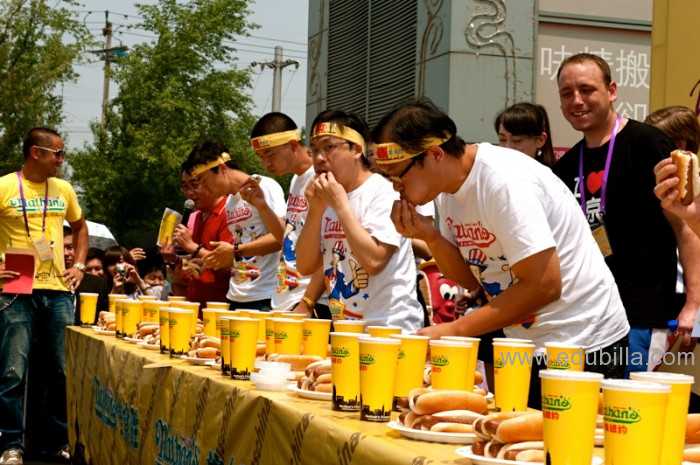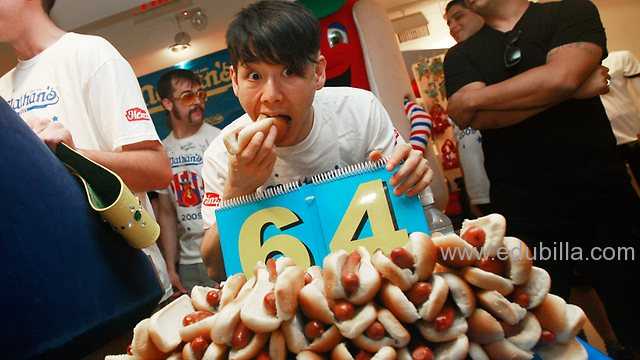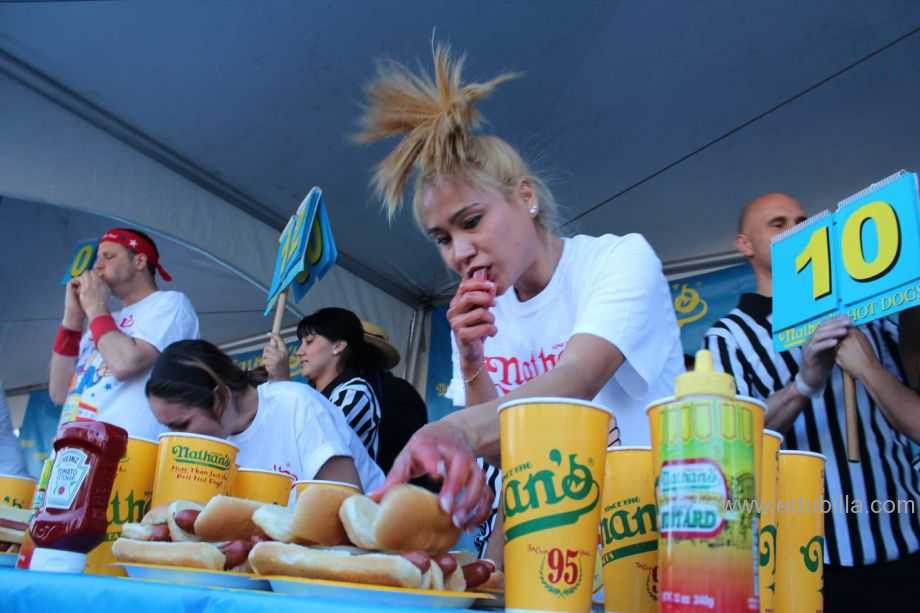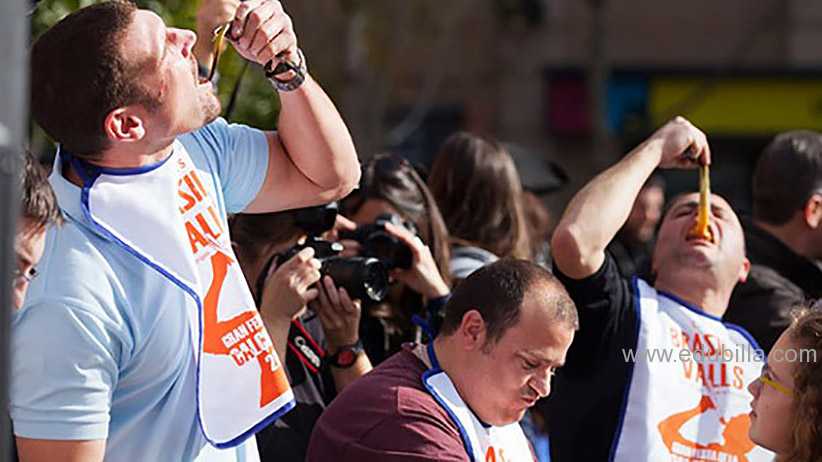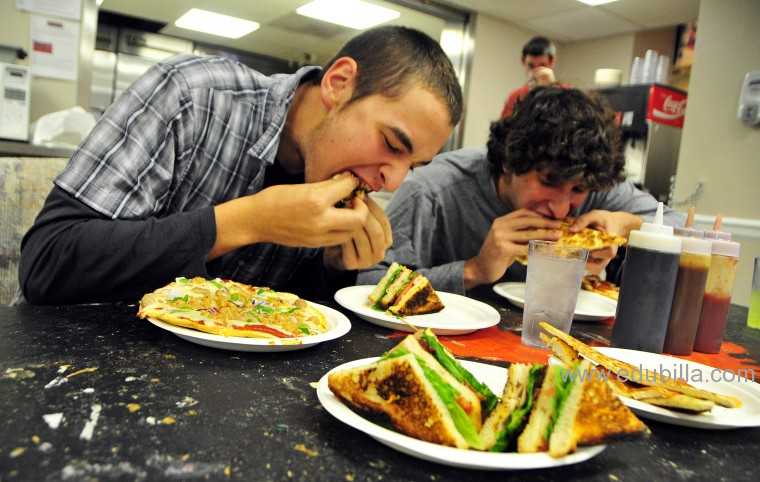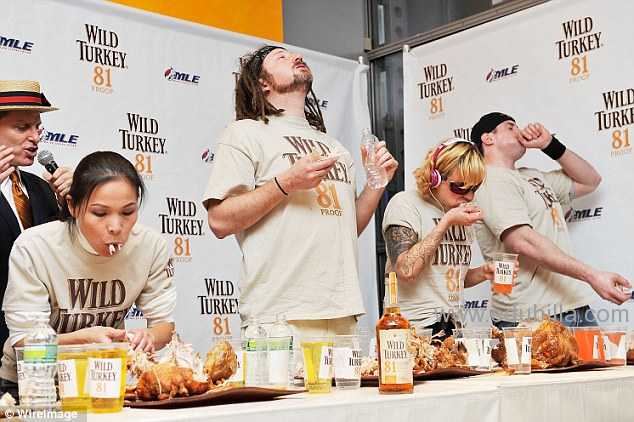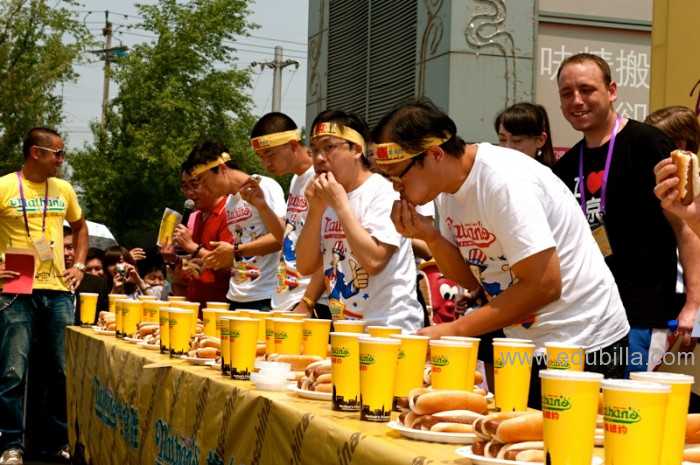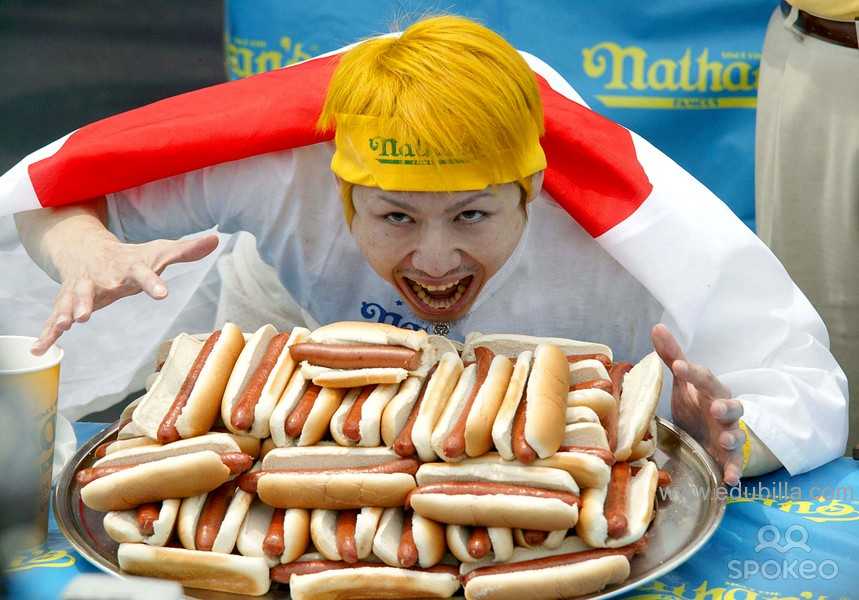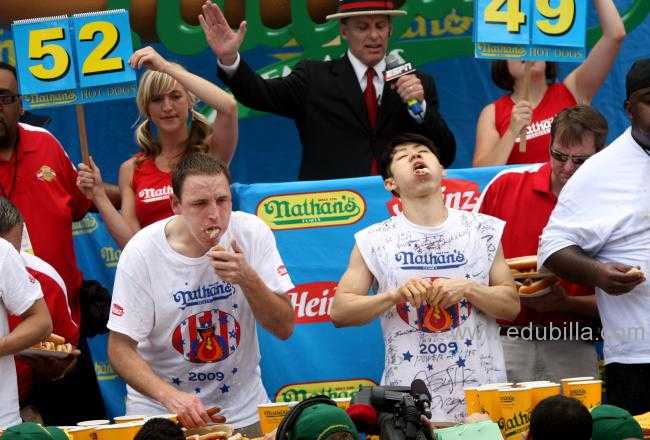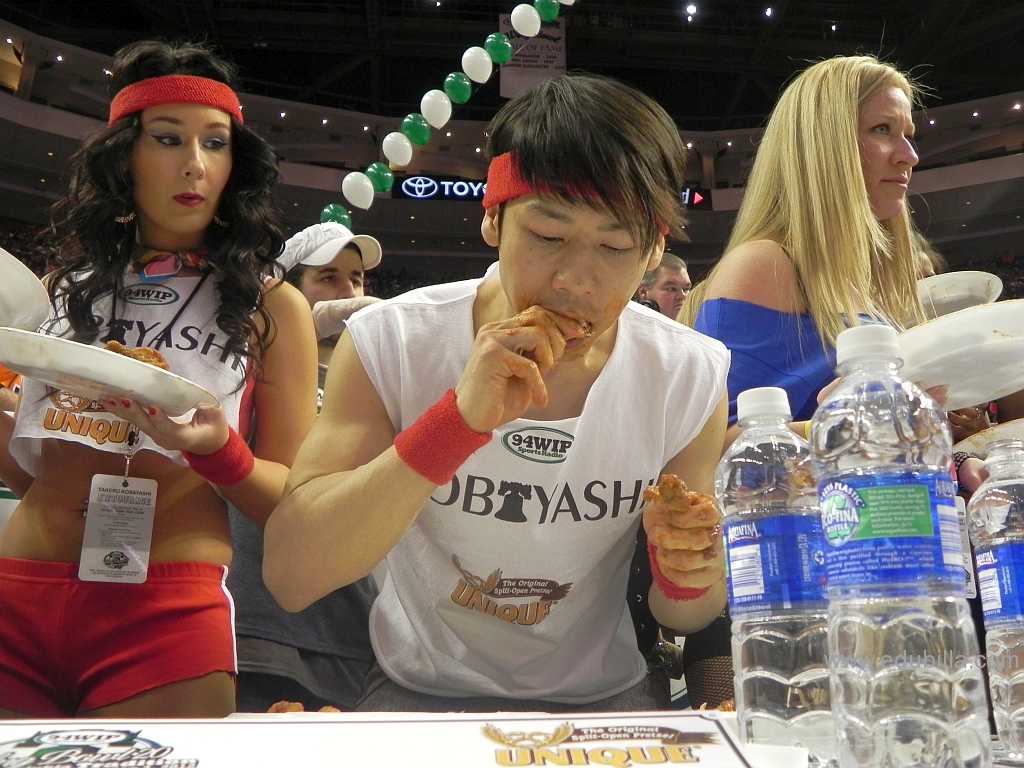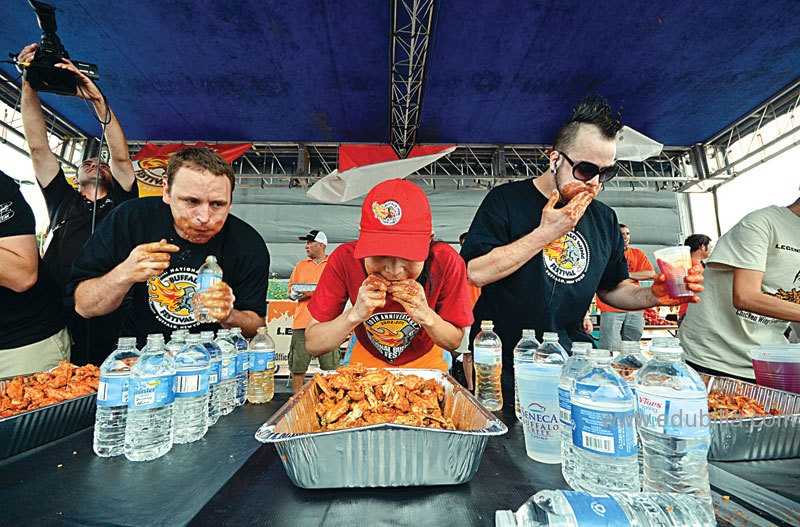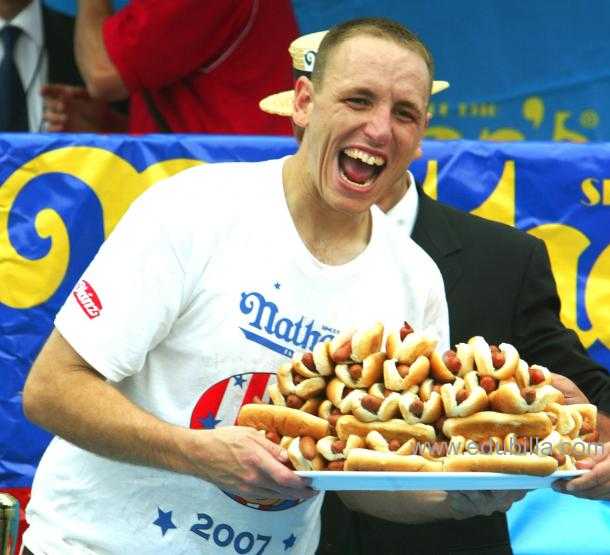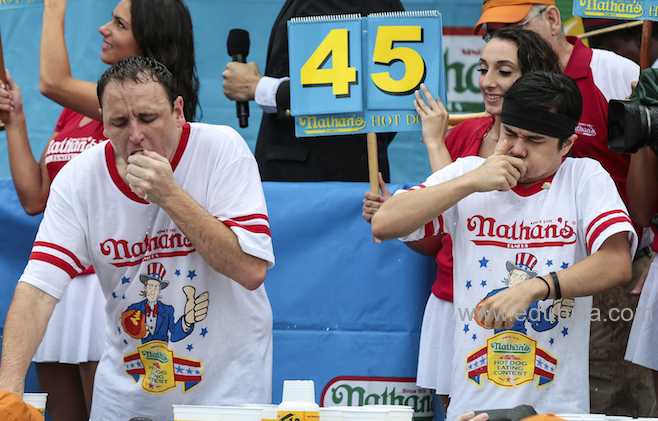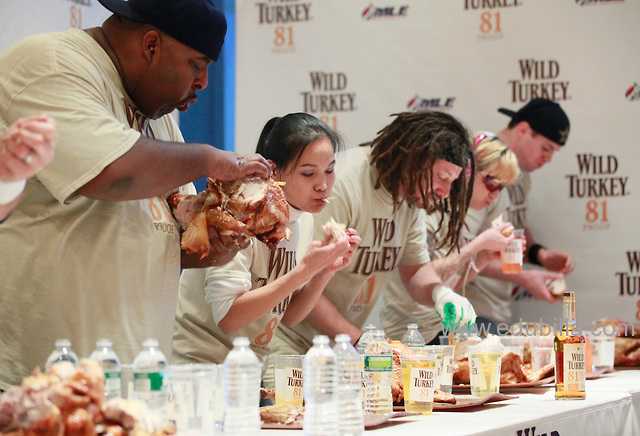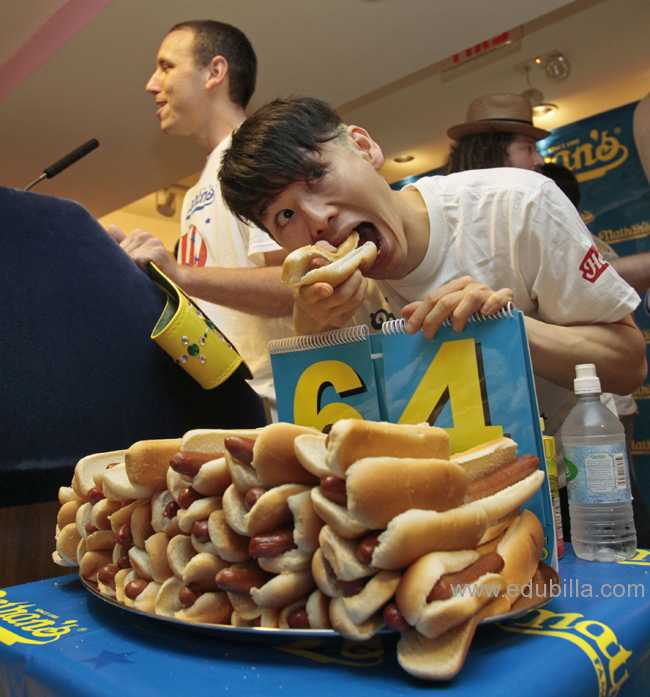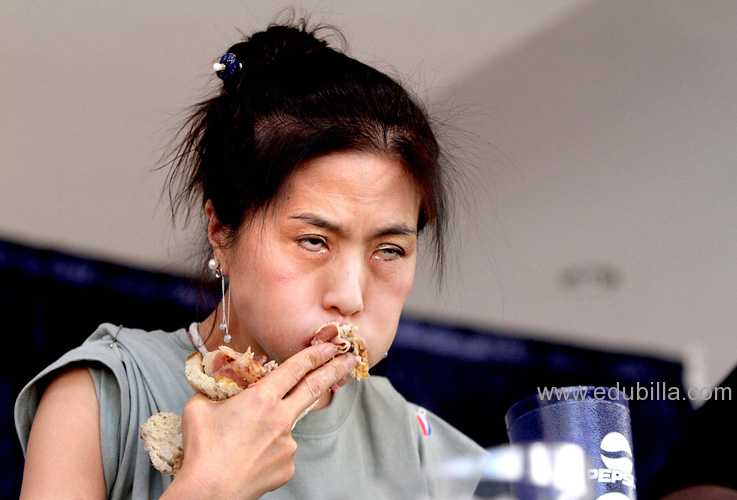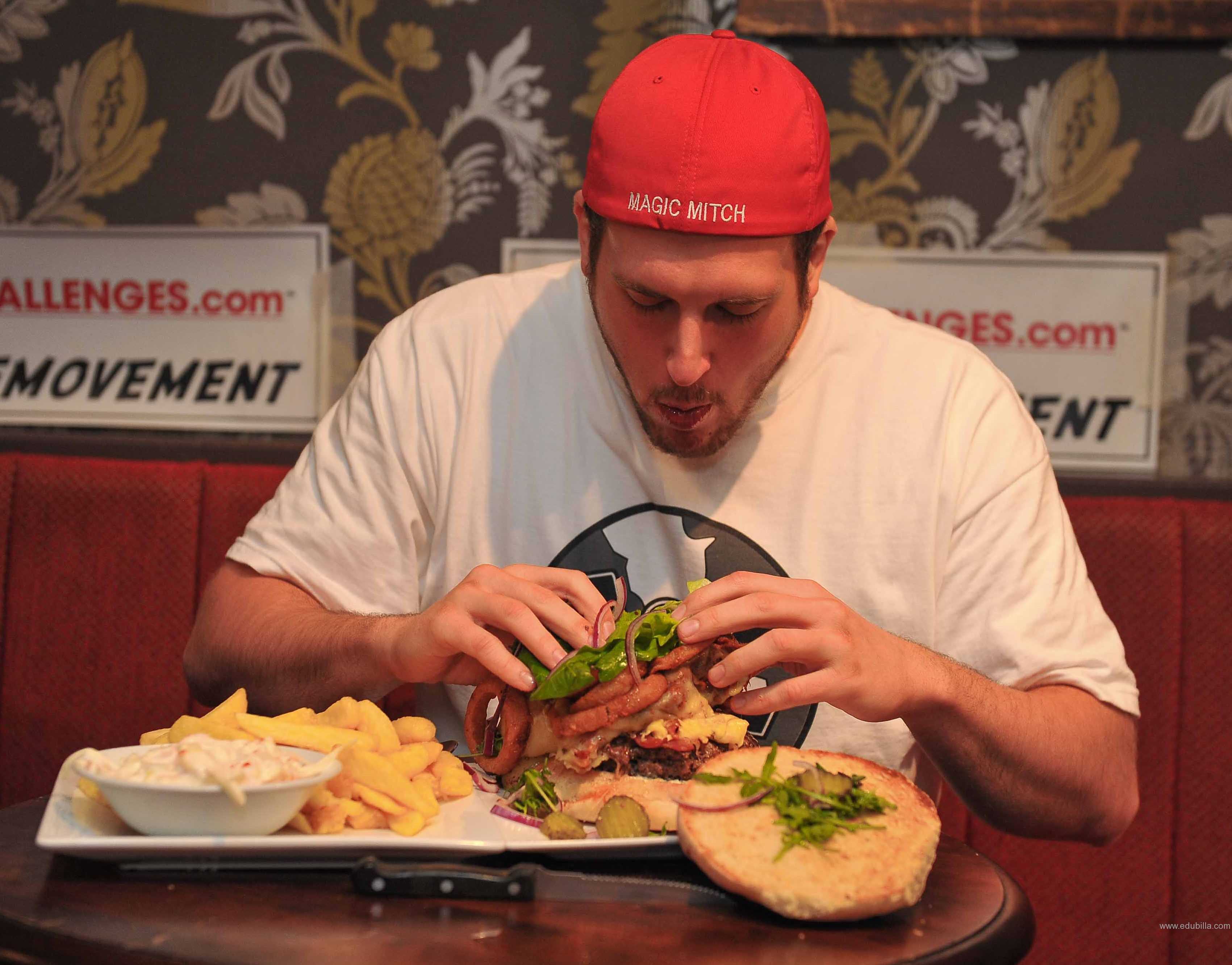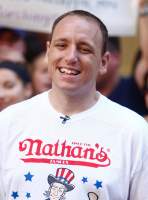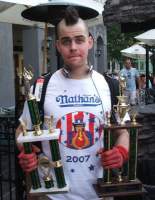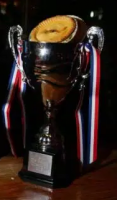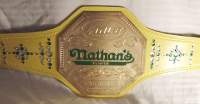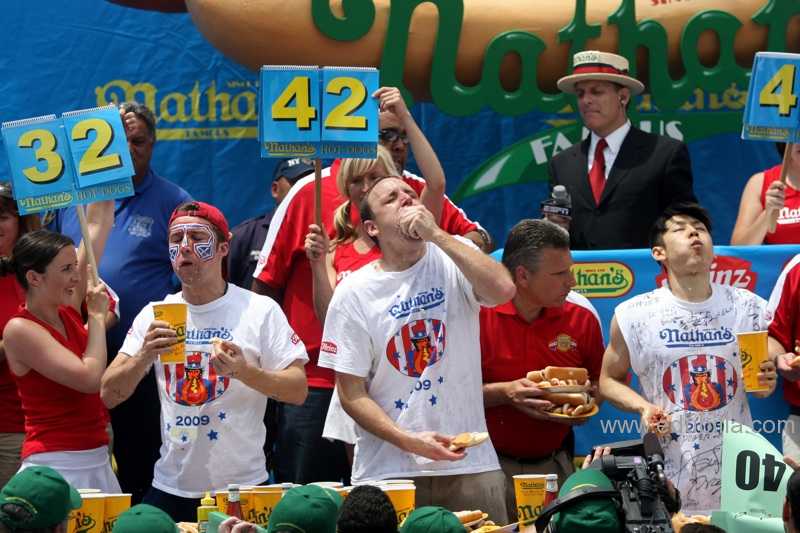
Overview Of Competitive eating
Competitive eating, or speed eating, is a sport in which participants compete against each other to consume large quantities of food in a short time period. Contests are typically eight to ten minutes long, although some competitions can last up to thirty minutes, with the person consuming the most food being declared the winner. Competitive eating is most popular in the United States, Canada, and Japan, where organized professional eating contests often offer prizes, including cash.
Food:
The type of food used in contests varies greatly, with each contest typically only using one type of food (e.g. a hot dog eating contest). Foods used in professional eating contests include hamburgers, hot dogs,pies, pancakes, chicken wings, asparagus, pizza, ribs, whole turkeys, among many other types of food. There is also a vegan hot dog eating competition held in Austin, Texas
Televised contests:
The annual Nathan's Hot Dog Eating Contest, which has been held every Fourth of July since the 1970s,is televised live on ESPN from Coney Island in the Brooklyn borough of New York City.
The annual Krystal Square Off hamburger eating contest has been televised on ESPN and, in 2008, on the Root Sports South network.
In 2002, the Fox Network aired a two-hour competitive eating contest called the Glutton Bowl.
Spike TV has broadcast several IFOCE-sanctioned competitive eating competitions as part of its "MLE Chowdown" series, including the St. Patrick's Day Chowdown in 2007 (corned beef and cabbage), the "Turkey Bowl" on Thanksgiving day in 2007 (whole turkeys with an undercard cranberry sauce contest), "Wedges 'n Wings" in 2007 (chicken wings and potato wedges), and "Ham 'n Eggs" during Super Bowl halftime in 2008.
Criticisms:
The chief criticism of competitive eating is the message the gluttonous sport sends as obesity levels rise among Americans and the example it sets for youth.
Others, like actor Ryan Reynolds in an editorial on The Huffington Post, contend that competitive eating is yet another example of Western gluttony at a time when so many others around the world are starving.In the same article, retired competitive eater Don "Moses" Lerman foreshadows the dangers of competitive eating when he admits "I'll stretch my stomach until it causes internal bleeding."
Dangers:
The argument that competitive eating can cause weight gain,which may lead to obesity and elevated cholesterol and blood pressure is common. The potential damage that competitive eating can cause to the human digestive system was the subject of a 2007 study by the University of Pennsylvania School of Medicine. The study observed professional eater Tim Janus, who ate 36 hot dogs in 10 minutes before doctors intervened. It was concluded that through training, Janus' stomach failed to have normal muscle contractions ca
lled peristalsis, a function which transfers food from the stomach down the digestive tract.
Other medical professionals contend that binge eating can cause stomach perforations in those with ulcers and gulping large quantities of water during training can lead to water intoxication, a condition which dilutes electrolytes in the blood.Gastroparesis, also known as stomach paralysis, is also a concern among those who routinely stretch their stomachs beyond capacity. The condition may lead to the stomach's inability to contract and lose its ability to empty itself. Side effects of gastroparesis include chronic indigestion, nausea and vomiting.
In October 2012, a 32-year-old man died while competitively eating live roaches and worms in a contest to win a ball python. An autopsy revealed he choked to death.On July 4, 2014, a 47-year-old competitive eater similarly choked to death during a hot dog eating contest.
Game Rules
Competitive eating contests often adhere to an 8, 10, 12 or 15 minute time limit. Most contests are presided over by a master of ceremonies, whose job is to announce the competitors prior to the contest and keep the audience engaged throughout the contest with enthusiastic play-by-play commentary and amusing anecdotes. A countdown from 10 usually takes place at the end of the contest, with all eating coming to an end with the expiration of time.
Many professional contests also employ a series of judges, whose role is to enforce the contest rules and warn eaters about infractions. Judges will also be called upon to count or weigh each competitor's food and certify the results of the contest prior to the winner being announced.
Chipmunking:
Many eaters will attempt to put as much food in their mouths as possible during the final seconds of a contest, a practice known by professionals as "chipmunking."If chipmunking is allowed in a contest, eaters are given a reasonable amount of time (typically less than two minutes) to swallow the food or risk a deduction from their final totals.
Dunking:
In many contests, except those adhering to "picnic style rules" mentioned previously, eaters are allowed to dunk foods in water or other liquids in order to soften the food and make it easier to chew and swallow. Dunking typically takes place with foods involving a bun or other doughy parts. Professional contests often enforce a limit on the amount of time competitors are allowed to dunk food.
Debris:
Competitors are expected to maintain a relatively clean eating surface throughout the contest. Excess debris after the contest may result in a deduction from the eater's final totals.
Vomiting:
If, at any point during or immediately after the contest, a competitor regurgitates any food, he or she will be disqualified. Vomiting, also known as a "reversal", or, as ESPN and the Nathan's Hot Dog Eating Contest call it, a "reversal of fortune", includes obvious signs of vomiting as well as any small amounts of food that may fall from the mouth deemed by judges to have come from the stomach. Small amounts of food already in the mouth prior to swallowing are excluded from this rule.
Equipments Need For Competitive eating
Food:
The type of food used in contests varies greatly, with each contest typically only using one type of food (e.g. a hot dog eating contest). Foods used in professional eating contests include hamburgers, hot dogs,pies, pancakes, chicken wings, asparagus, pizza, ribs, whole turkeys, among many other types of food. There is also a vegan hot dog eating competition held in Austin, Texas.
History Of Competitive eating
Traditionally, eating contests, often involving pies, were events at county fairs. The recent surge in the popularity of competitive eating is due in large part to the development of the Nathan's Hot Dog Eating Contest, an annual holiday tradition that has been held on July 4 virtually every year since the 1970s at Coney Island.
1970-The annual Nathan's Hot Dog Eating Contest, which has been held every Fourth of July since the 1970s, is televised live on ESPN from Coney Island in the Brooklyn borough of New York City.
2000-The hot dog rivalry between Joey Chestnut and Takeru Kobayashi, the leading Japanese eater, is the best known scandal in competitive eating, and has hurled the sport to international fame in the mid-2000s.
2001-In 2001, Takeru Kobayashi transformed the competition and the world of competitive eating by downing 50 hot dogs – smashing the previous record (25.5). The event generates enormous media attention and has been aired on ESPN for the past eight years, contributing to the growth of the competitive eating phenomenon.
2008-In 2008, Chestnut and Kobayashi tied at 59 hot dogs in 10 minutes (the time span had previously been 12 minutes), and Chestnut won in an eatoff in which he was the first of the two competitors to finish eating 5 hot dogs in overtime, earning Chestnut his second consecutive title.
Great Moments In Competitive-Eating History
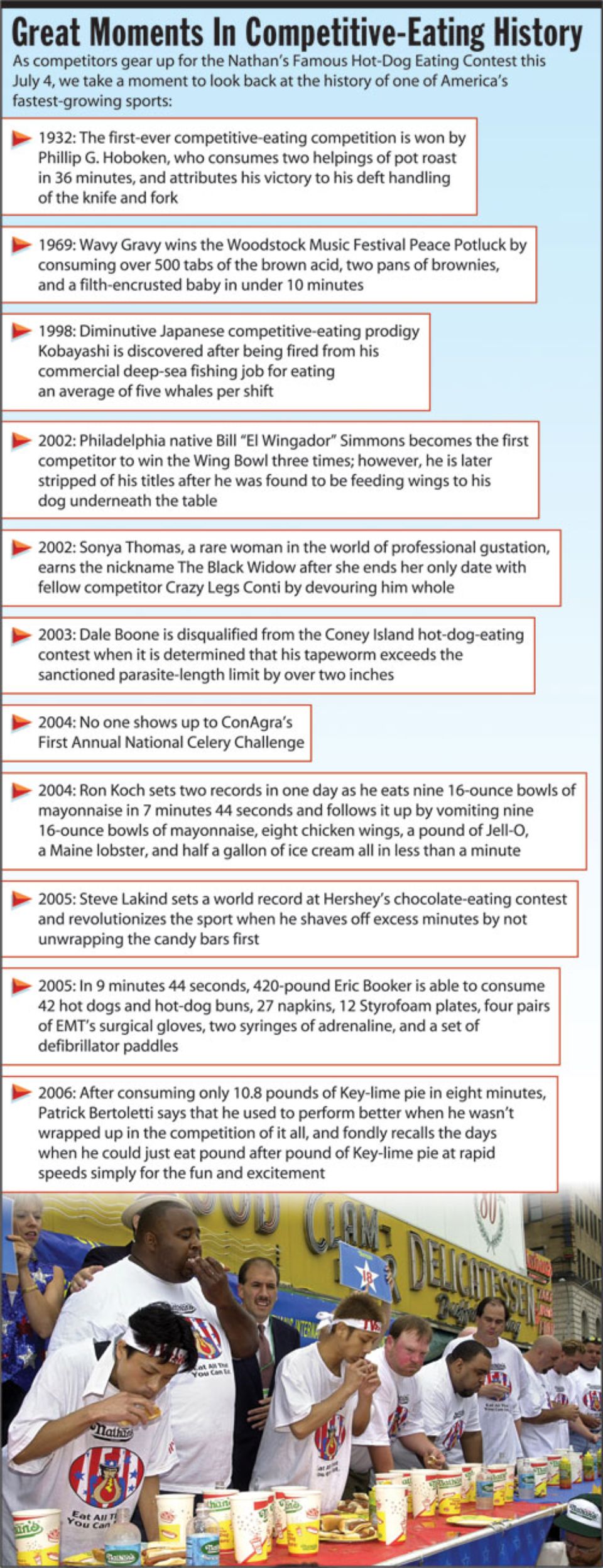
Origin Of Competitive eating
Competitive eating as we know it began as an American pastime in the latter half of the nineteenth century. Pie eating was the norm at state fairs, but as the buzz quickly gained momentum, we saw the introduction of other foods. Not to mention the excitement friendly wagers brought. Nowadays, it’s seen as a sport. According to the sport’s governing body, Major League Eating, 1916 marked the official start of competitive eating. This was the year that Nathan’s Famous held its first Fourth of July hot dog eating contest in Coney Island.
Governing Bodies
All Pro Eating:
- All Pro Eating is the only Independent Competitive Eating organization in the world and also officially sanctions competitive eating contests.
- Recognized All Pro Eating Competitive Eaters include Molly Schuyler, Eric "Silo" Dahl, Jamie "The Bear" McDonald and Stephanie "Xanadu" Torres.
- All Pro Eating has been significantly featured in American and International media including a strong connection with television projects produced by TV Tokyo.
- In 2010, All Pro Eating was joined by new eaters including former IFOCE members "Jammin" Joe LaRue, Chris "The Mad Greek" Abatsas and newcomer "Munchin" Mike Longo.
- The year started off with the USquare National Eating Championship in Madison Wisconsin. Ian The Invader Hickman won with 102 ounces of food court food in 8 minutes.
- On June 5 in Rockville Centre, NY "Munchin" Mike Longo won the National Cheese Steak Eating Championship with 4.05 cheese steaks eating in 7 minutes.
- "Munchin" Mike Longo also won the Little Jimmy's National Italian Ice Eating Championship again beating AICE eating star Ian The Invader Hickman and legendary eater King George Van Laar, eating 4 lbs 1.25 ounces of Italian ice in 7 minutes.
- In Middlebury. Connecticut The Caribbean Food Eating Championship took place where Joel The Cannon Podelsky won the National Bun and Cheese National Championship eating 40 ounces in 4 min and 43 sec. King George Van Laar won the National Beef Pattie Eating Championship eating 60oz of beef patties in 7 minutes 32 sec.
- 5th Annual American Meatball Eating Championship took place in Midlothian, Illinois. Bob “KILLER” Kuhns of Pittsburgh, PA took 1st with 36.5 meatballs in 7 minutes to win $1,000.
To Visit All Pro Eating Click Here.
IFOCE:
Major League Eating (MLE) is an organization that sanctions professional competitive eating events and television specials. The stated mission of Major League Eating is to maintain a safe environment for all events, to create a dynamic and enjoyable fan experience, and to help sponsors develop, publicize and execute eating events in a wide variety of food disciplines.The league airs its annual Nathan's Famous Fourth of July International Hot Dog Eating Contest on ESPN.
History
MLE was founded as the International Federation of Competitive Eating, Inc. (IFOCE) is an organization that supervises and regulates eating contests across the globe, acting as a central resource for the sport. Top events include the Nathan's Hot Dog Eating Contest, La Costena "Feel the Heat" Jalapeño Eating Challenge, and the Krystal Square Off World Hamburger Eating Championship and the National Buffalo Wing Festival. The IFOCE was founded in 1997 by brothers George and Richard Shea.
The IFOCE counts thousands of competitors in its league, including top-ranked eaters such as Joey Chestnut of California, "Megatoad" Matt Stonie of California, Sonya Thomas of Virginia, and "Notorious B.O.B." Bob Shoudt of Philadelphia. The IFOCE currently is in a dispute with Takeru Kobayashi of Japan over whether competitors may also participate in contests not sanctioned by the IFOCE.The IFOCE develops, promotes and runs more than one hundred events in all variety of venues during its annual circuit.
The organization also produces television shows on competitive eating. In 2002, IFOCE produced Glutton Bowl, a two-hour eating event on the Fox Network. In 2007 the IFOCE produced four one-hour programs for Spike TV under the title Chowdown. In 2006, the IFOCE produced three hours of programming on ESPN, including a one-hour live show on the 2005 Nathan’s Famous hot dog eating contest and one-hour shows on the Johnsonville Foods Bratwurst contest and the Krystal Hamburger contest. The Alka-Seltzer U.S. Open of Competitive eating, a three-hour elimination tournament was a 2005 IFOCE production. In addition, the IFOCE produced four 30-minute shows under the title of Tour de Gorge and six 30-minute shows titled Eats of Strength for INHD.
IFOCE changed its name to Major League Eating (MLE) in the early 2000s.
Nationwide branches:
The IFOCE maintains principal offices in New York City and operates in the United States. The Discovery Channel, Travel Channel, the TV Food Network and the UK’s Channel Four have also aired one-hour documentaries on eating and the IFOCE and Fox Television aired a two-hour IFOCE championship.
The IFOCE maintains a ranking system for competitions it has sanctioned. IFOCE safety measures ensure that all sanctioned matches occur in a controlled environment under the supervision of a licensed emergency medical technician and that only individuals over the age of eighteen compete.
TV Ratings:
The ESPN2 telecast of the 2014 Nathan’s event generated a 1.6 rating and 2.8 million viewers, making it the most watched telecast in the contest's history.The ESPN2 airing also ranks as the 6th highest-rated and 5th most-watched telecast of the year on ESPN2, behind NCAA Football, NBA and World Cup.
To Visit MLE Click Here.
Awards Related To Competitive eating
MTV Movie Awards Popcorn-Eating Competition:
Competing in the event will be world popcorn-eating champion Crazy Legs Conti (seven bags of popcorn in 12 minutes), world chili-eating champion Rich LeFevre (1 ½ gallons of chili in 10 minutes), 100-pound world oyster-eating champion Sonya Thomas (46 dozen oysters in 10 minutes), and world posole-eating champion Carlene LeFevre (6.8 pounds of posole in 12 minutes), among others.
Eater Awards for New York City:
To recap, Eater's local editors in 24 cities nominated candidates for five major local categories:
- Restaurant of the Year
- Chef of the Year
- Bartender of the Year
- So Hot Right Now Restaurant
- Stone Cold Stunner
Eater readers then voted to narrow the field to a final three in each category. From that final three, the Eater editorial team chose one to move forward and the Eater.com braintrust got together to decide the national winners. Without further ado, here's who came out on top in New York City.
Sample Documents Of Competitive eating
-Michael Jordan





